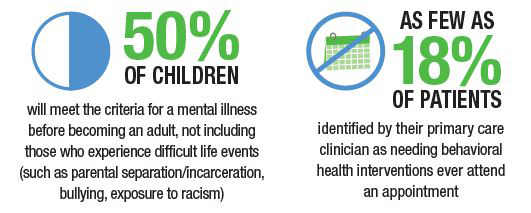Breaking the Cycle: Preventing and Treating Addiction in Youth
Breaking the Cycle: Preventing and Treating Addiction in Youth https://pediatricsnationwide.org/wp-content/uploads/2018/10/Breaking-the-Cycle_Banner-web-1024x575.gif 1024 575 Abbie Miller Abbie Miller https://pediatricsnationwide.org/wp-content/uploads/2023/05/051023BT016-Abbie-Crop.jpg- October 22, 2018
- Abbie Miller

Virtually all addictions begin during adolescence. And nearly 4 million 12-25 year olds in the United States have a substance abuse problem, according to the U.S. Department of Health & Human Services. Substance abuse in adolescents is not restricted to opioids, but in the midst of this national crisis, too many young people are finding themselves in the grips of opioid addiction.
In 2016, 3.6 percent of adolescents aged 12-17 reported misusing opioids over the past year. Among 18-25 year olds, that number was even higher: 7.3 percent. Between 1999 and 2016, 56,428 adolescents and young adults (ages 15-24 years) died from a drug overdose.
These staggering statistics underscore the need for effective treatment programs. At Nationwide Children’s Hospital, members of the Adolescent Medicine Substance Abuse Program and Medication-Assisted Treatment for Addiction (MATA) Program have found that medication-assisted treatment (MAT), combined with behavioral health interventions and a focus on patient retention, results in more patients who enter and stay in recovery.
Treating Addiction With Medication
Despite the growing body of evidence showing the effectiveness of MAT in the treatment of opioid use disorders, providers – and even patients and parents – have been hesitant to embrace it. For some, treating opioid addiction with an opioid seems counterintuitive. They see the goal of recovery as being substance-free. For those for whom MAT has been life-saving, however, the understanding that medication can be part of a recovery process that enables them to live healthy, productive lives has made all the difference.
Relapse without MAT is high. According to the National Institute of Drug Abuse, MAT decreases the incidence of opioid use, opioid-related overdose deaths, criminal activity and infectious disease transmission. It also increases social functioning and retention in treatment.
Unfortunately, the adolescents and young adults are among those most likely not to receive MAT. According to a study recently published in JAMA Pediatrics, a majority of adolescents and young adults diagnosed with opioid use disorder are not receiving the recommended MAT. In fact, only 24 percent of youths aged 13-22 years receive one of the three FDA-approved medications – methadone, buprenorphine and naltrexone – within 3 months of diagnosis. For those under age 18, only 1 in 21 receives medication.
“There are far too few pediatric providers who prescribe medications for addiction, and stigma is still playing a role in deterring many patients and families from using these evidence-based medications,” said Scott Hadland, MD, MPH, MS, pediatrician and researcher at the Grayken Center for Addiction at Boston Medical Center in a press release.
In the MATA Program at Nationwide Children’s, the team uses buprenorphine/naloxone (brand names Suboxone® and Zubsolv®) as part of the comprehensive program. But that’s not the case everywhere. Among all treatment programs for youth listed by the Substance Abuse and Mental Health Services Administration, only 37 percent offer MAT. In some cases, programs may deny admission to young people who are already on a maintenance medication.
“We use buprenorphine for three main purposes: first, to suppress withdrawal; second, to block or decrease the euphoric effect of illicit opiates; third, to titrate doses to minimize or even eliminate the craving for opioids. In combination with talk therapy and meeting other health needs, this approach gives our young patients the best chance at recovery,” says Steve Matson, MD, medical director of the Adolescent Substance Abuse Program at Nationwide Children’s.
Beyond MAT
Patients in the MATA Program face a wide variety of challenges in addition to addiction, including pregnancy, sexually transmitted infections, hepatitis C, depression and anxiety. Integration into a primary care clinic supports coordinated care and reduces intake times. “We treat the whole patient, not just the withdrawal issues,” Dr. Matson says.
The key components of the MATA Program at Nationwide Children’s include:
- Point-of-care urine testing
- Narcan® overdose kits provided to every patient
- Weekly visit to the Adolescent Medicine Clinic
- Mental health assessments at 3 and 6 weeks
And now, the team can add integrated behavioral health support to the list. In the summer of 2018, Ashley Garrett, LISW-S, LICDC, became the MATA outpatient clinician. The position is partially funded by a grant from the Nationwide Children’s Foundation. “Therapy for patients with addiction is incredibly important,” she says. “Many have a trauma history that has impacted their self-efficacy, and an appropriate therapeutic relationship is instrumental in demonstrating healthy relationships, improving one’s self-concept and developing skills needed for life.”
Some people are reluctant to participate in therapy, she adds. They don’t want to “talk feelings.” But getting a feel of the emotional landscape that contributed to addiction is essential for recovery.
Even so, therapy as part of treatment for addiction isn’t all talk about feelings.
“One of the things that we work on in addiction recovery therapy is answering these questions: What does a life in recovery look like for you? What does a recovered life look like? Once we know where we’re going, we can talk about strategies to support and sustain that recovered life,” Garrett says.
Treatment and prevention have a lot in common from the behavioral health perspective. Preventing a teenager from abusing drugs starts long before they hit adolescence. And it requires more than scare tactics, “just say no” campaigns, and a parent’s watchful eye. So does treatment.
Building resilience and making sure behavioral health needs are met is crucial to helping people at risk for addiction disorders. In fact, the U.S. Department of Health & Human Services lists “building strong relationships with adolescents” as the first step to connecting with youth on drug prevention. It’s also the first step to connecting with them on treatment.
“Historically, I thought one of the biggest challenges to treatment for patients with addiction from the behavioral health side was managing the externalizing behaviors – the opposition and aggression,” says Garrett. “After being in the field for several years, I see that it really comes down to love and belonging. The behaviors are a defense mechanism and a means of self-preservation.”
“We can teach skills and techniques to manage substance use triggers and support recovery,” she continues. “But it’s more difficult to help find loving and supportive people to help them feel worthy to pursue recovery.”
Those relationships can come from support groups and by destigmatizing addiction disorders.
In his visit to Nationwide Children’s in March 2018, National Institutes of Health Director Francis Collins, MD, PhD, toured the MATA Program. He acknowledged the difficulties that youth with addiction face and how the program can help.
“These kids, who virtually all come from difficult circumstances, feel it is safe to come and have a warm embrace from a care team that really wants to get to know them and isn’t going to stigmatize them,” he said.
Managing Dual Diagnoses
More than half of people with an addiction to opioids also have a behavioral health diagnosis. If left untreated, that behavioral health problem can further drive the addiction. “Dual diagnosis” is the term used when someone has both a mood disorder and a substance abuse disorder.
“Historically, substance use treatment and behavioral health were siloed,” says Garrett. “Nationwide Children’s has an incredible amount of collaboration, which I believe is still rare. It’s getting better, however, as dual diagnosis is more widely accepted.”
In many cases of dual diagnosis, substance abuse begins as an attempt to self-medicate for depression, anxiety or other behavioral health problems. It may have led to the addiction, and it may persist after the patient begins treatment for the substance abuse disorder.
“Self-medication with marijuana and alcohol may complicate recovery when the patient is participating in the MAT program,” says Dr. Matson. “We work with them on this. It’s better for them to get the behavioral health support they need and to get on appropriate prescription medication for those issues if it is needed.”
Dr. Matson says that he and his team have learned from experience that developing relationships with these patients is vital to helping them move forward in the recovery process.
“Getting them off opioids and onto buprenorphine is the first step. Then, you work with them on the other stuff,” he says. “If you push too hard too fast, they don’t always come back. The best thing you can do is meet them where they are. Then you can move forward together.”
Seeking a Recovered Lifestyle
Recovery is hard. In addition to the physical symptoms of withdrawal, patients in recovery face an entire upheaval of their world. The people, places and things that are most familiar to them may be triggers of addiction and barriers to their sobriety. A person seeking recovery is asked to let go of all of it. And many do so without the backing of supportive family and friends.
“People in recovery are brave. There’s an incredible potential for success,” says Garrett. “They are resourceful, determined and creative. And with support, they can channel all of their skills and potential, and lead a recovered life.”
But getting there is a long road. Perhaps especially so for young people who may resent the restrictions their sobriety may impose and who don’t have a strong support system.
“It’s a hard thing for a 20 year old in a recovery program to consider that they are going to turn 21 and not be able to go have a drink. And maybe not ever. The jury is still out on whether a person in recovery can consume any addictive or commonly abused substance,” says Dr. Matson. “We teach our patients strategies for maintaining lifelong sobriety – no opioids, no alcohol, no marijuana.”
The life changes required for recovery also include restricting or eliminating contact with the people and places who were part of the addicted life. For a person in recovery, maintaining relationships with friends and connections who participated in or supported the addiction is difficult. For some youth, that means distancing themselves from their family.
“Some of these young people don’t have any support for their recovery at home,” Dr. Matson says. “That makes it very hard for them to continue treatment – in our program or any other.”
Keep Them Coming Back
From 2009 to 2012 at Nationwide Children’s, only 9 percent of patients stayed in the program at 12 months. This low retention rate mirrored those of others programs around the country.
To improve retention in the program, Dr. Matson and his team embarked on a quality improvement project. Among the actions taken, they began an incentive program funded by grant support.
“The incentives make a big difference,” says Dr. Matson. “A little reward – such as drawing a gift card out of a bowl – for achieving a milestone in their recovery gives our patients recognition of their hard work. And that $25 gift certificate to Walmart might help provide the gas money they need to get to their next appointment.”
Other interventions included additional social work support and follow-up calls to remind patients to come to their appointments. Through a QI project, retention increased to 40 percent at 12 months and 60 percent at 6 months.
What’s Next?
“I was inspired by the clinic,” said Dr. Collins after his visit. “Many of these kids started into opioid difficulties as early as age 12 or 13 and are now in the place where they need medication-assisted treatment to allow them to get free of this. It’s a tough challenge and very few places have a facility that can handle that kind of circumstance. I wish we had lots of those clinics all over the country. There are only a few, maybe because people aren’t quite sure that they would work – it looks like it’s working.”
As the need for treatment centers that can care for youth with addiction increases, the staff at Nationwide Children’s are training the next generation of clinicians who are joining the front lines.
“Some of our fellows are actually moving on to start similar clinics in other institutions in the region,” says Dr. Matson. “We’re really proud of that. The more opportunities for treatment that these kids have, the better. Patients in our clinic travel from several counties to get care – some of them driving more than an hour each way.”
The biggest challenge for the future of addiction treatment in youth is much the same as that for adults. It’s expensive. And things like incentive programs, continued therapy, a broader focus on detox and follow-up care aren’t always covered by insurance.
“We depend on a lot of grants to do the things that make our program as effective as it can be,” says Dr. Matson. “Looking at how we fund and support comprehensive treatment programs across the country is essential to continued improvement and success in treating this epidemic. These kids are trying to do better, but it’s not easy for them. We’re working hard to provide the support they need to succeed.

About the author
Abbie (Roth) Miller, MWC, is a passionate communicator of science. As the manager, medical and science content, at Nationwide Children’s Hospital, she shares stories about innovative research and discovery with audiences ranging from parents to preeminent researchers and leaders. Before coming to Nationwide Children’s, Abbie used her communication skills to engage audiences with a wide variety of science topics. She is a Medical Writer Certified®, credentialed by the American Medical Writers Association.
-
Abbie Millerhttps://pediatricsnationwide.org/author/abbie-miller/
-
Abbie Millerhttps://pediatricsnationwide.org/author/abbie-miller/
-
Abbie Millerhttps://pediatricsnationwide.org/author/abbie-miller/
-
Abbie Millerhttps://pediatricsnationwide.org/author/abbie-miller/
- Posted In:
- Features







